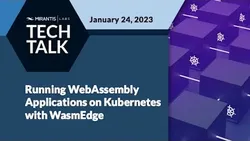
Running WebAssembly Applications on Kubernetes with WasmEdge Mirantis Labs - Tech Talks 
This Tech Talk from Mirantis Labs covers the use of WebAssembly and WasmEdge to run applications on Kubernetes. It begins by introducing WebAssembly and discussing the differences between Wasm modules and container images. It then looks at common use-cases for WebAssembly and explains what WasmEdge is. Finally, a live demo is given to demonstrate how to run WasmEdge and Wasm bytecode inside a slim Kubernetes cluster. ▼
ADVERTISEMENT
Course Feature
![]() Cost:
Cost:
Free
![]() Provider:
Provider:
Youtube
![]() Certificate:
Certificate:
Paid Certification
![]() Language:
Language:
English
![]() Start Date:
Start Date:
On-Demand
Course Overview
❗The content presented here is sourced directly from Youtube platform. For comprehensive course details, including enrollment information, simply click on the 'Go to class' link on our website.
Updated in [February 21st, 2023]
- Intro
- Prerequisites for today's demo links above
- What is WebAssembly?
- Wasm modules vs. container images
- Common use-cases for WebAssembly
- What is WasmEdge?
- Live Demo: Run WasmEdge & Wasm bytecode inside a slim container
- Demo: create the "hello wasm" application
- Demo: compile Wasm app to Wasm module
- Demo: testing our module & building the slim container
- Demo: running our slim Wasm container on Kubernetes
- A look at some alternative tools to use with WebAssembly
- Now let's look at WebAssembly from an Operator's POV
- Additional reading on WebAssembly & WasmEdge
- Outro
(Please note that we obtained the following content based on information that users may want to know, such as skills, applicable scenarios, future development, etc., combined with AI tools, and have been manually reviewed)
This course provides an overview of running WebAssembly applications on Kubernetes with WasmEdge Mirantis Labs - Tech Talks. Participants will learn about the basics of WebAssembly, Wasm modules vs. container images, common use-cases for WebAssembly, and what WasmEdge is. Through a series of live demos, participants will learn how to run WasmEdge & Wasm bytecode inside a slim container, create the "hello wasm" application, compile Wasm app to Wasm module, test the module & build the slim container, and run the slim Wasm container on Kubernetes. Participants will also get a look at some alternative tools to use with WebAssembly and an overview of WebAssembly from an Operator's POV. Finally, participants will be provided with additional reading on WebAssembly & WasmEdge. Prerequisites for today's demo are provided in the links above.
[Applications]
After this course, it is suggested that participants apply the knowledge gained by running WebAssembly applications on Kubernetes with WasmEdge Mirantis Labs. They can use the live demo to run WasmEdge and Wasm bytecode inside a slim container, create the "hello wasm" application, compile Wasm app to Wasm module, test the module and build the slim container, and run the slim Wasm container on Kubernetes. Additionally, participants can explore alternative tools to use with WebAssembly and look at WebAssembly from an Operator's POV. Further reading on WebAssembly and WasmEdge is also recommended.
[Career Paths]
1. WebAssembly Developer: WebAssembly developers are responsible for creating and maintaining applications written in WebAssembly. They must be knowledgeable in the language and its associated tools, as well as have a good understanding of the underlying architecture. They must also be able to debug and optimize code for performance. As WebAssembly continues to gain popularity, the demand for WebAssembly developers is expected to increase.
2. Kubernetes Operator: Kubernetes Operators are responsible for managing and deploying applications on Kubernetes clusters. They must be knowledgeable in the Kubernetes platform and its associated tools, as well as have a good understanding of the underlying architecture. They must also be able to debug and optimize code for performance. As Kubernetes continues to gain popularity, the demand for Kubernetes Operators is expected to increase.
3. WasmEdge Engineer: WasmEdge Engineers are responsible for developing and maintaining applications written in WebAssembly and running on Kubernetes clusters. They must be knowledgeable in the language and its associated tools, as well as have a good understanding of the underlying architecture. They must also be able to debug and optimize code for performance. As WasmEdge continues to gain popularity, the demand for WasmEdge Engineers is expected to increase.
4. Cloud Architect: Cloud Architects are responsible for designing and implementing cloud-based solutions. They must be knowledgeable in cloud computing technologies and have a good understanding of the underlying architecture. They must also be able to debug and optimize code for performance. As cloud computing continues to gain popularity, the demand for Cloud Architects is expected to increase.
[Education Paths]
1. Computer Science Degree: A computer science degree is a great way to learn the fundamentals of web development and gain the skills needed to develop and deploy web applications. This degree path will provide learners with the knowledge and skills to develop and deploy web applications using web technologies such as HTML, CSS, JavaScript, and WebAssembly. Additionally, learners will gain an understanding of the underlying principles of computer science, such as algorithms, data structures, and software engineering. This degree path is becoming increasingly popular as web development continues to grow in popularity.
2. Software Engineering Degree: A software engineering degree is a great way to learn the fundamentals of software engineering and gain the skills needed to develop and deploy web applications. This degree path will provide learners with the knowledge and skills to develop and deploy web applications using web technologies such as HTML, CSS, JavaScript, and WebAssembly. Additionally, learners will gain an understanding of the underlying principles of software engineering, such as software design, software architecture, and software testing. This degree path is becoming increasingly popular as web development continues to grow in popularity.
3. Cloud Computing Degree: A cloud computing degree is a great way to learn the fundamentals of cloud computing and gain the skills needed to develop and deploy web applications on cloud platforms. This degree path will provide learners with the knowledge and skills to develop and deploy web applications using web technologies such as HTML, CSS, JavaScript, and WebAssembly. Additionally, learners will gain an understanding of the underlying principles of cloud computing, such as cloud architecture, cloud security, and cloud scalability. This degree path is becoming increasingly popular as cloud computing continues to grow in popularity.
4. Artificial Intelligence Degree: An artificial intelligence degree is a great way to learn the fundamentals of artificial intelligence and gain the skills needed to develop and deploy web applications using AI technologies. This degree path will provide learners with the knowledge and skills to develop and deploy web applications using web technologies such as HTML, CSS, JavaScript, and WebAssembly. Additionally, learners will gain an understanding of the underlying principles of artificial intelligence, such as machine learning, natural language processing, and computer vision. This degree path is becoming increasingly popular as artificial intelligence continues to grow in popularity.
Course Provider

Provider Youtube's Stats at AZClass
Discussion and Reviews
0.0 (Based on 0 reviews)
Explore Similar Online Courses

Pennsylvania Real Estate Salesperson Exam: Study Guide & Practice

Making a Black Panther Helmet 3D Printed Cosplay Mask

Python for Informatics: Exploring Information

Social Network Analysis

Introduction to Systematic Review and Meta-Analysis

The Analytics Edge

DCO042 - Python For Informatics

Causal Diagrams: Draw Your Assumptions Before Your Conclusions

Whole genome sequencing of bacterial genomes - tools and applications

Kubernetes for Beginners (Kubernetes + Docker)

Scalable Microservices with Kubernetes


Start your review of Running WebAssembly Applications on Kubernetes with WasmEdge Mirantis Labs - Tech Talks